Analysis of Final Accounts for Business Performance
VerifiedAdded on 2020/10/22
|15
|4520
|158
AI Summary
The assignment provided is a report on financial analysis and accounting, which includes the preparation and interpretation of final accounts for a business. The report presents a detailed analysis of the balance sheet, income statement, and cash flow statement, providing an overview of the company's financial position and performance. It also discusses the importance of final accounts in understanding a business's actual position and performance, and how they can be used to make informed decisions. The report is based on a hypothetical business scenario, which includes a balance sheet and income statement, as well as notes on accounting procedures and references to relevant literature.
Contribute Materials
Your contribution can guide someone’s learning journey. Share your
documents today.

Prepare final accounts
for sole traders and
partnerships
for sole traders and
partnerships
Secure Best Marks with AI Grader
Need help grading? Try our AI Grader for instant feedback on your assignments.
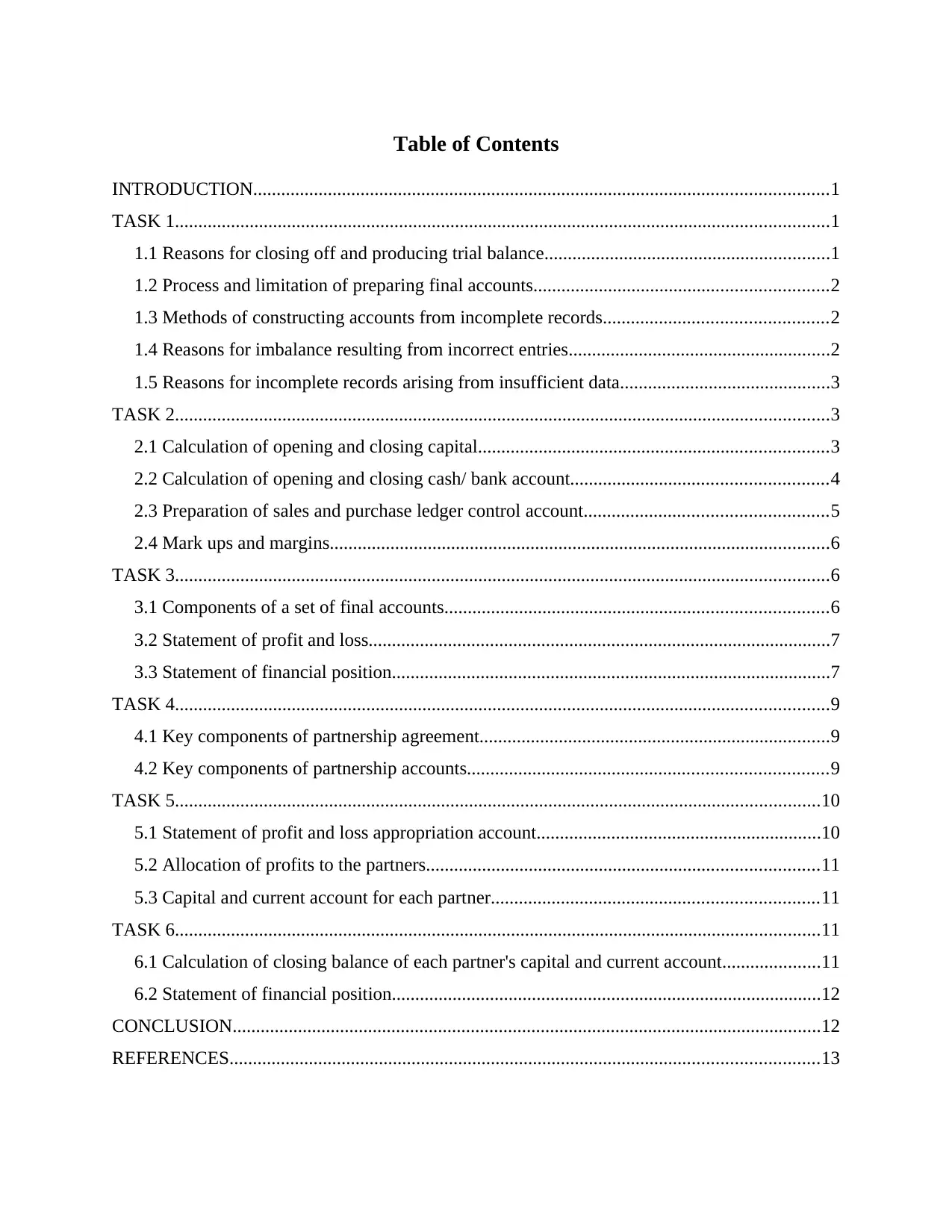
Table of Contents
INTRODUCTION...........................................................................................................................1
TASK 1............................................................................................................................................1
1.1 Reasons for closing off and producing trial balance.............................................................1
1.2 Process and limitation of preparing final accounts...............................................................2
1.3 Methods of constructing accounts from incomplete records................................................2
1.4 Reasons for imbalance resulting from incorrect entries........................................................2
1.5 Reasons for incomplete records arising from insufficient data.............................................3
TASK 2............................................................................................................................................3
2.1 Calculation of opening and closing capital...........................................................................3
2.2 Calculation of opening and closing cash/ bank account.......................................................4
2.3 Preparation of sales and purchase ledger control account....................................................5
2.4 Mark ups and margins...........................................................................................................6
TASK 3............................................................................................................................................6
3.1 Components of a set of final accounts..................................................................................6
3.2 Statement of profit and loss...................................................................................................7
3.3 Statement of financial position..............................................................................................7
TASK 4............................................................................................................................................9
4.1 Key components of partnership agreement...........................................................................9
4.2 Key components of partnership accounts.............................................................................9
TASK 5..........................................................................................................................................10
5.1 Statement of profit and loss appropriation account.............................................................10
5.2 Allocation of profits to the partners....................................................................................11
5.3 Capital and current account for each partner......................................................................11
TASK 6..........................................................................................................................................11
6.1 Calculation of closing balance of each partner's capital and current account.....................11
6.2 Statement of financial position............................................................................................12
CONCLUSION..............................................................................................................................12
REFERENCES..............................................................................................................................13
INTRODUCTION...........................................................................................................................1
TASK 1............................................................................................................................................1
1.1 Reasons for closing off and producing trial balance.............................................................1
1.2 Process and limitation of preparing final accounts...............................................................2
1.3 Methods of constructing accounts from incomplete records................................................2
1.4 Reasons for imbalance resulting from incorrect entries........................................................2
1.5 Reasons for incomplete records arising from insufficient data.............................................3
TASK 2............................................................................................................................................3
2.1 Calculation of opening and closing capital...........................................................................3
2.2 Calculation of opening and closing cash/ bank account.......................................................4
2.3 Preparation of sales and purchase ledger control account....................................................5
2.4 Mark ups and margins...........................................................................................................6
TASK 3............................................................................................................................................6
3.1 Components of a set of final accounts..................................................................................6
3.2 Statement of profit and loss...................................................................................................7
3.3 Statement of financial position..............................................................................................7
TASK 4............................................................................................................................................9
4.1 Key components of partnership agreement...........................................................................9
4.2 Key components of partnership accounts.............................................................................9
TASK 5..........................................................................................................................................10
5.1 Statement of profit and loss appropriation account.............................................................10
5.2 Allocation of profits to the partners....................................................................................11
5.3 Capital and current account for each partner......................................................................11
TASK 6..........................................................................................................................................11
6.1 Calculation of closing balance of each partner's capital and current account.....................11
6.2 Statement of financial position............................................................................................12
CONCLUSION..............................................................................................................................12
REFERENCES..............................................................................................................................13
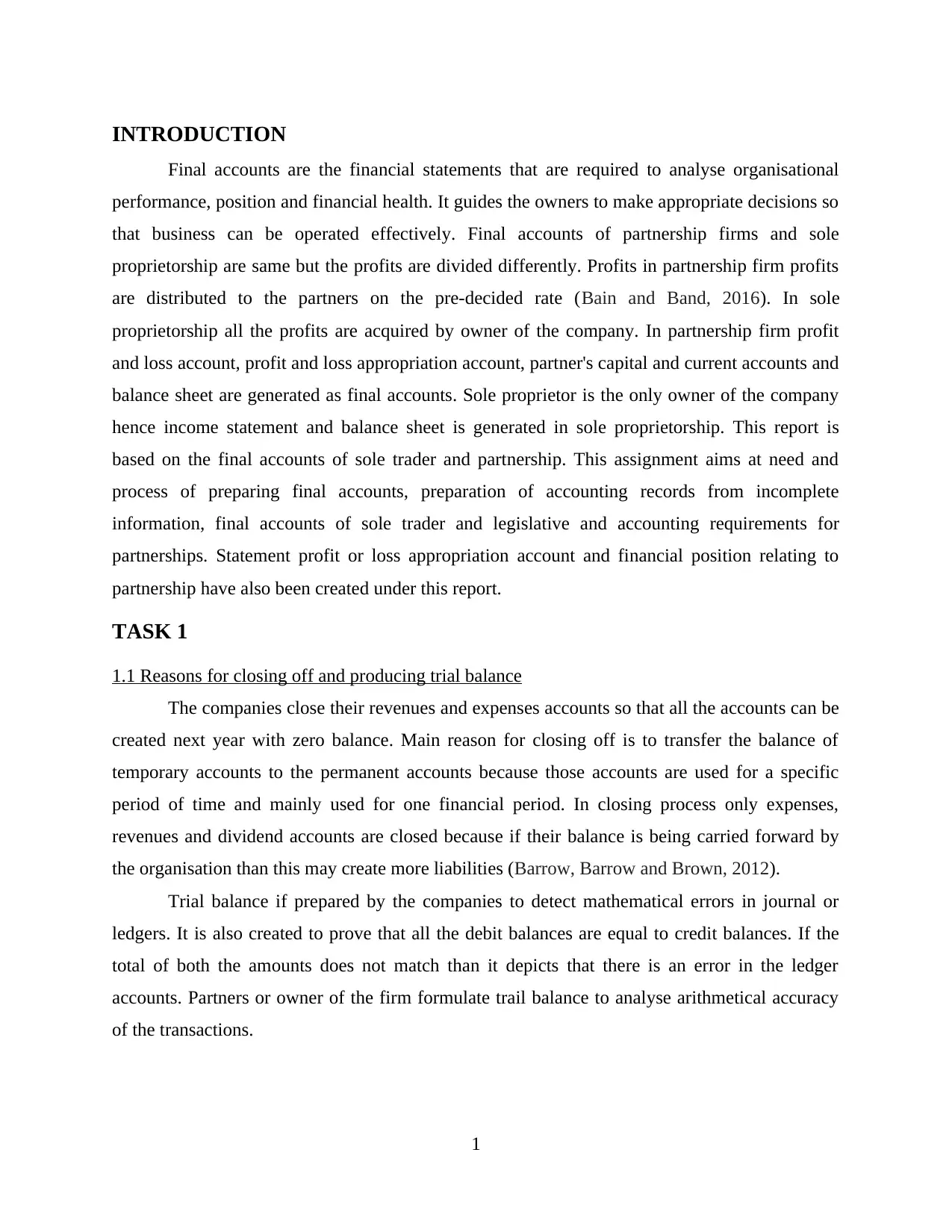
INTRODUCTION
Final accounts are the financial statements that are required to analyse organisational
performance, position and financial health. It guides the owners to make appropriate decisions so
that business can be operated effectively. Final accounts of partnership firms and sole
proprietorship are same but the profits are divided differently. Profits in partnership firm profits
are distributed to the partners on the pre-decided rate (Bain and Band, 2016). In sole
proprietorship all the profits are acquired by owner of the company. In partnership firm profit
and loss account, profit and loss appropriation account, partner's capital and current accounts and
balance sheet are generated as final accounts. Sole proprietor is the only owner of the company
hence income statement and balance sheet is generated in sole proprietorship. This report is
based on the final accounts of sole trader and partnership. This assignment aims at need and
process of preparing final accounts, preparation of accounting records from incomplete
information, final accounts of sole trader and legislative and accounting requirements for
partnerships. Statement profit or loss appropriation account and financial position relating to
partnership have also been created under this report.
TASK 1
1.1 Reasons for closing off and producing trial balance
The companies close their revenues and expenses accounts so that all the accounts can be
created next year with zero balance. Main reason for closing off is to transfer the balance of
temporary accounts to the permanent accounts because those accounts are used for a specific
period of time and mainly used for one financial period. In closing process only expenses,
revenues and dividend accounts are closed because if their balance is being carried forward by
the organisation than this may create more liabilities (Barrow, Barrow and Brown, 2012).
Trial balance if prepared by the companies to detect mathematical errors in journal or
ledgers. It is also created to prove that all the debit balances are equal to credit balances. If the
total of both the amounts does not match than it depicts that there is an error in the ledger
accounts. Partners or owner of the firm formulate trail balance to analyse arithmetical accuracy
of the transactions.
1
Final accounts are the financial statements that are required to analyse organisational
performance, position and financial health. It guides the owners to make appropriate decisions so
that business can be operated effectively. Final accounts of partnership firms and sole
proprietorship are same but the profits are divided differently. Profits in partnership firm profits
are distributed to the partners on the pre-decided rate (Bain and Band, 2016). In sole
proprietorship all the profits are acquired by owner of the company. In partnership firm profit
and loss account, profit and loss appropriation account, partner's capital and current accounts and
balance sheet are generated as final accounts. Sole proprietor is the only owner of the company
hence income statement and balance sheet is generated in sole proprietorship. This report is
based on the final accounts of sole trader and partnership. This assignment aims at need and
process of preparing final accounts, preparation of accounting records from incomplete
information, final accounts of sole trader and legislative and accounting requirements for
partnerships. Statement profit or loss appropriation account and financial position relating to
partnership have also been created under this report.
TASK 1
1.1 Reasons for closing off and producing trial balance
The companies close their revenues and expenses accounts so that all the accounts can be
created next year with zero balance. Main reason for closing off is to transfer the balance of
temporary accounts to the permanent accounts because those accounts are used for a specific
period of time and mainly used for one financial period. In closing process only expenses,
revenues and dividend accounts are closed because if their balance is being carried forward by
the organisation than this may create more liabilities (Barrow, Barrow and Brown, 2012).
Trial balance if prepared by the companies to detect mathematical errors in journal or
ledgers. It is also created to prove that all the debit balances are equal to credit balances. If the
total of both the amounts does not match than it depicts that there is an error in the ledger
accounts. Partners or owner of the firm formulate trail balance to analyse arithmetical accuracy
of the transactions.
1
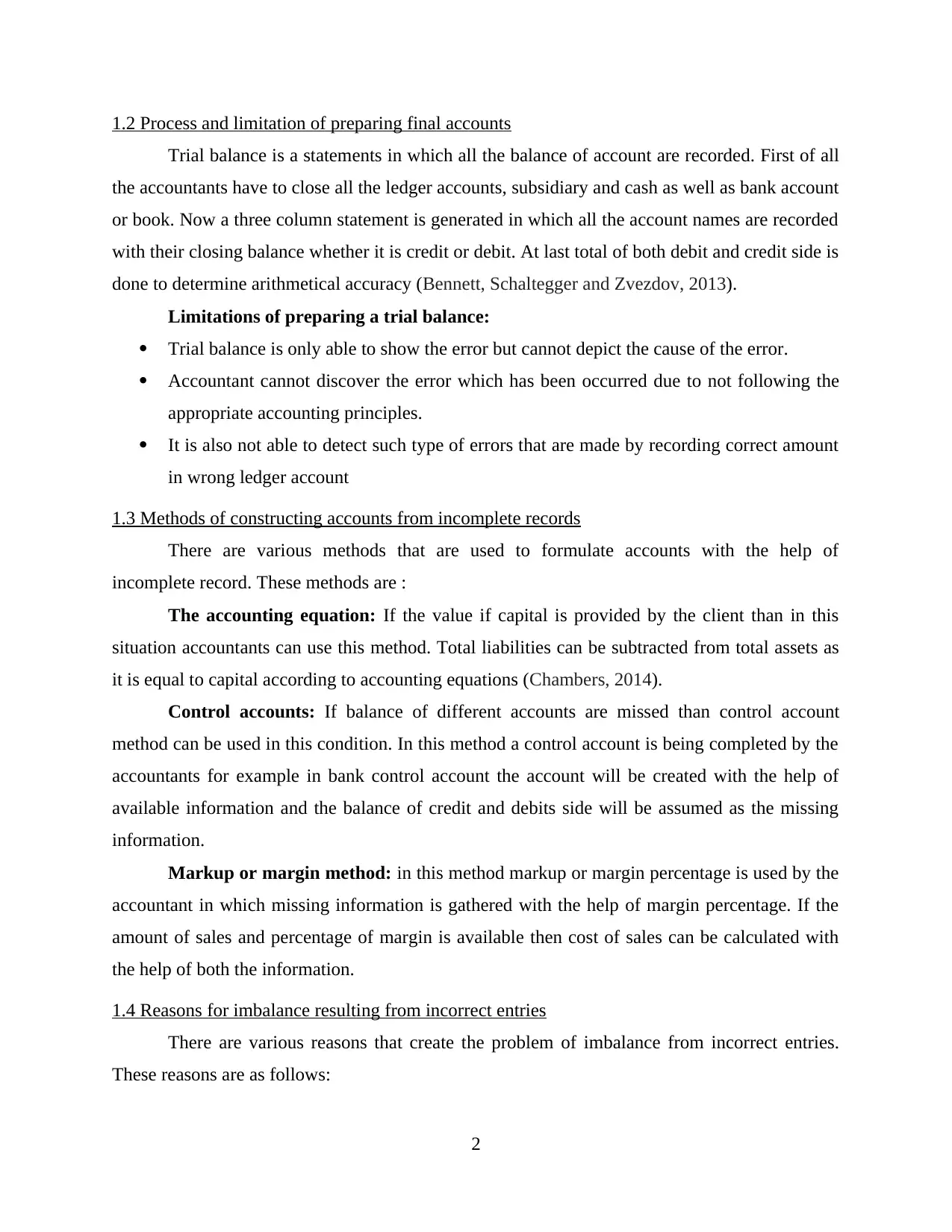
1.2 Process and limitation of preparing final accounts
Trial balance is a statements in which all the balance of account are recorded. First of all
the accountants have to close all the ledger accounts, subsidiary and cash as well as bank account
or book. Now a three column statement is generated in which all the account names are recorded
with their closing balance whether it is credit or debit. At last total of both debit and credit side is
done to determine arithmetical accuracy (Bennett, Schaltegger and Zvezdov, 2013).
Limitations of preparing a trial balance:
Trial balance is only able to show the error but cannot depict the cause of the error.
Accountant cannot discover the error which has been occurred due to not following the
appropriate accounting principles.
It is also not able to detect such type of errors that are made by recording correct amount
in wrong ledger account
1.3 Methods of constructing accounts from incomplete records
There are various methods that are used to formulate accounts with the help of
incomplete record. These methods are :
The accounting equation: If the value if capital is provided by the client than in this
situation accountants can use this method. Total liabilities can be subtracted from total assets as
it is equal to capital according to accounting equations (Chambers, 2014).
Control accounts: If balance of different accounts are missed than control account
method can be used in this condition. In this method a control account is being completed by the
accountants for example in bank control account the account will be created with the help of
available information and the balance of credit and debits side will be assumed as the missing
information.
Markup or margin method: in this method markup or margin percentage is used by the
accountant in which missing information is gathered with the help of margin percentage. If the
amount of sales and percentage of margin is available then cost of sales can be calculated with
the help of both the information.
1.4 Reasons for imbalance resulting from incorrect entries
There are various reasons that create the problem of imbalance from incorrect entries.
These reasons are as follows:
2
Trial balance is a statements in which all the balance of account are recorded. First of all
the accountants have to close all the ledger accounts, subsidiary and cash as well as bank account
or book. Now a three column statement is generated in which all the account names are recorded
with their closing balance whether it is credit or debit. At last total of both debit and credit side is
done to determine arithmetical accuracy (Bennett, Schaltegger and Zvezdov, 2013).
Limitations of preparing a trial balance:
Trial balance is only able to show the error but cannot depict the cause of the error.
Accountant cannot discover the error which has been occurred due to not following the
appropriate accounting principles.
It is also not able to detect such type of errors that are made by recording correct amount
in wrong ledger account
1.3 Methods of constructing accounts from incomplete records
There are various methods that are used to formulate accounts with the help of
incomplete record. These methods are :
The accounting equation: If the value if capital is provided by the client than in this
situation accountants can use this method. Total liabilities can be subtracted from total assets as
it is equal to capital according to accounting equations (Chambers, 2014).
Control accounts: If balance of different accounts are missed than control account
method can be used in this condition. In this method a control account is being completed by the
accountants for example in bank control account the account will be created with the help of
available information and the balance of credit and debits side will be assumed as the missing
information.
Markup or margin method: in this method markup or margin percentage is used by the
accountant in which missing information is gathered with the help of margin percentage. If the
amount of sales and percentage of margin is available then cost of sales can be calculated with
the help of both the information.
1.4 Reasons for imbalance resulting from incorrect entries
There are various reasons that create the problem of imbalance from incorrect entries.
These reasons are as follows:
2
Secure Best Marks with AI Grader
Need help grading? Try our AI Grader for instant feedback on your assignments.
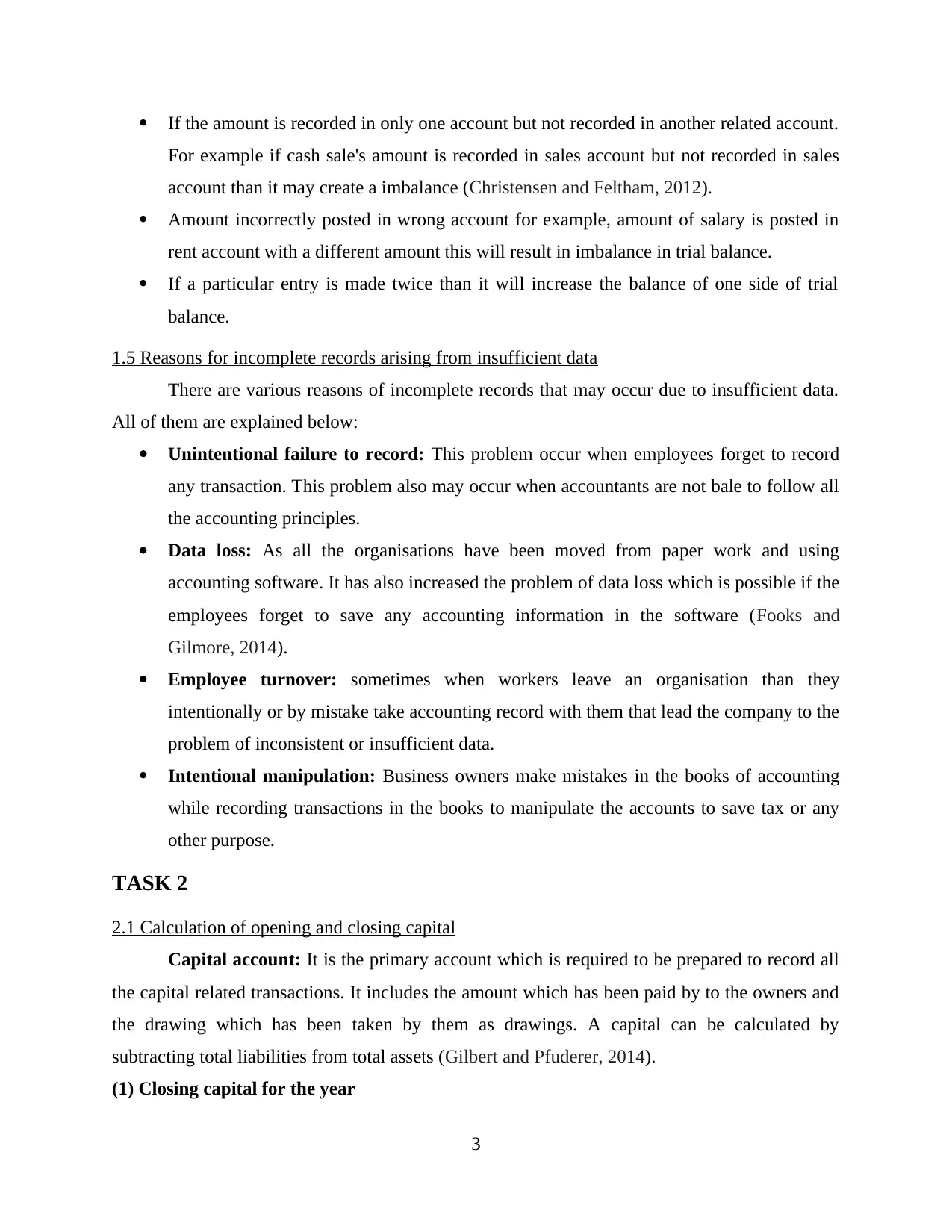
If the amount is recorded in only one account but not recorded in another related account.
For example if cash sale's amount is recorded in sales account but not recorded in sales
account than it may create a imbalance (Christensen and Feltham, 2012).
Amount incorrectly posted in wrong account for example, amount of salary is posted in
rent account with a different amount this will result in imbalance in trial balance.
If a particular entry is made twice than it will increase the balance of one side of trial
balance.
1.5 Reasons for incomplete records arising from insufficient data
There are various reasons of incomplete records that may occur due to insufficient data.
All of them are explained below:
Unintentional failure to record: This problem occur when employees forget to record
any transaction. This problem also may occur when accountants are not bale to follow all
the accounting principles.
Data loss: As all the organisations have been moved from paper work and using
accounting software. It has also increased the problem of data loss which is possible if the
employees forget to save any accounting information in the software (Fooks and
Gilmore, 2014).
Employee turnover: sometimes when workers leave an organisation than they
intentionally or by mistake take accounting record with them that lead the company to the
problem of inconsistent or insufficient data.
Intentional manipulation: Business owners make mistakes in the books of accounting
while recording transactions in the books to manipulate the accounts to save tax or any
other purpose.
TASK 2
2.1 Calculation of opening and closing capital
Capital account: It is the primary account which is required to be prepared to record all
the capital related transactions. It includes the amount which has been paid by to the owners and
the drawing which has been taken by them as drawings. A capital can be calculated by
subtracting total liabilities from total assets (Gilbert and Pfuderer, 2014).
(1) Closing capital for the year
3
For example if cash sale's amount is recorded in sales account but not recorded in sales
account than it may create a imbalance (Christensen and Feltham, 2012).
Amount incorrectly posted in wrong account for example, amount of salary is posted in
rent account with a different amount this will result in imbalance in trial balance.
If a particular entry is made twice than it will increase the balance of one side of trial
balance.
1.5 Reasons for incomplete records arising from insufficient data
There are various reasons of incomplete records that may occur due to insufficient data.
All of them are explained below:
Unintentional failure to record: This problem occur when employees forget to record
any transaction. This problem also may occur when accountants are not bale to follow all
the accounting principles.
Data loss: As all the organisations have been moved from paper work and using
accounting software. It has also increased the problem of data loss which is possible if the
employees forget to save any accounting information in the software (Fooks and
Gilmore, 2014).
Employee turnover: sometimes when workers leave an organisation than they
intentionally or by mistake take accounting record with them that lead the company to the
problem of inconsistent or insufficient data.
Intentional manipulation: Business owners make mistakes in the books of accounting
while recording transactions in the books to manipulate the accounts to save tax or any
other purpose.
TASK 2
2.1 Calculation of opening and closing capital
Capital account: It is the primary account which is required to be prepared to record all
the capital related transactions. It includes the amount which has been paid by to the owners and
the drawing which has been taken by them as drawings. A capital can be calculated by
subtracting total liabilities from total assets (Gilbert and Pfuderer, 2014).
(1) Closing capital for the year
3
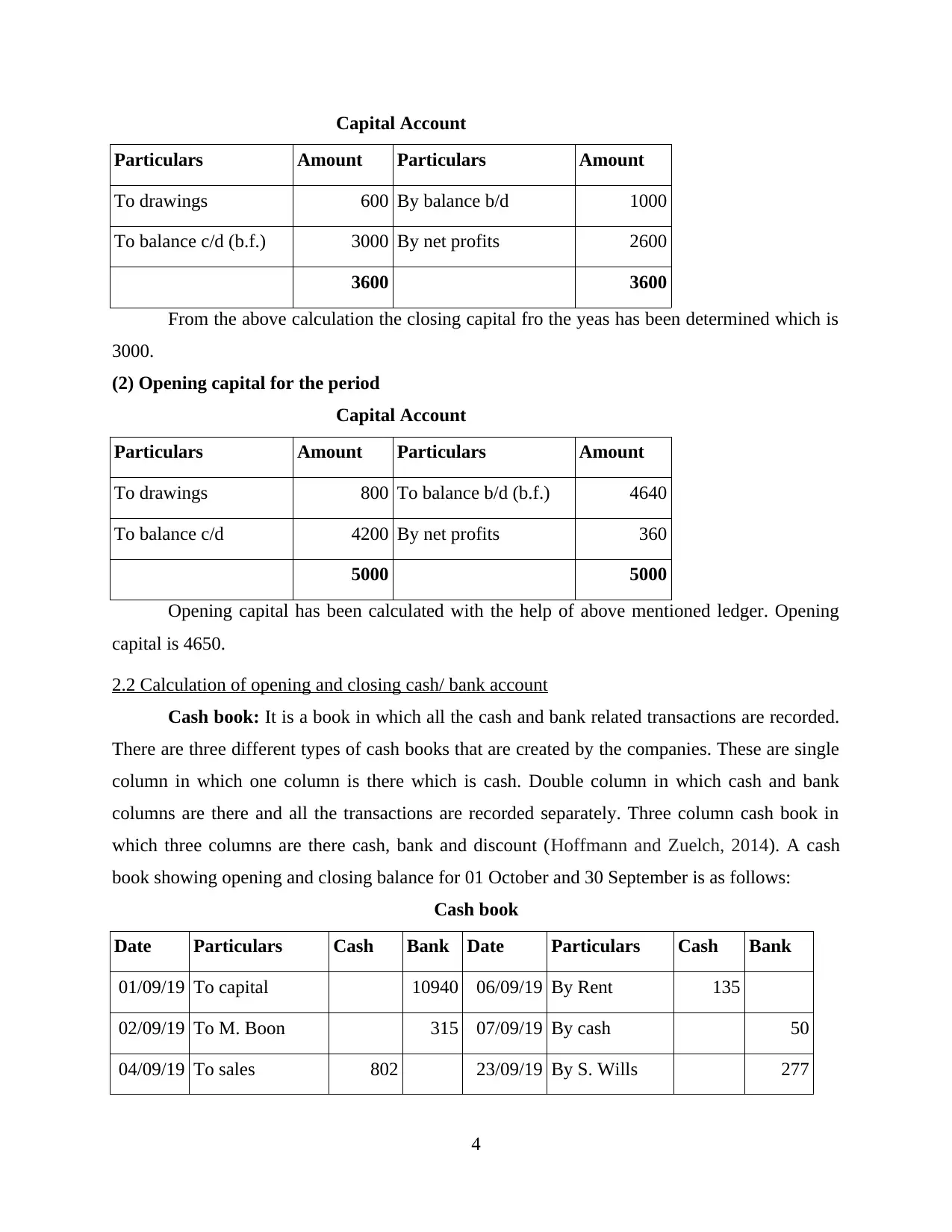
Capital Account
Particulars Amount Particulars Amount
To drawings 600 By balance b/d 1000
To balance c/d (b.f.) 3000 By net profits 2600
3600 3600
From the above calculation the closing capital fro the yeas has been determined which is
3000.
(2) Opening capital for the period
Capital Account
Particulars Amount Particulars Amount
To drawings 800 To balance b/d (b.f.) 4640
To balance c/d 4200 By net profits 360
5000 5000
Opening capital has been calculated with the help of above mentioned ledger. Opening
capital is 4650.
2.2 Calculation of opening and closing cash/ bank account
Cash book: It is a book in which all the cash and bank related transactions are recorded.
There are three different types of cash books that are created by the companies. These are single
column in which one column is there which is cash. Double column in which cash and bank
columns are there and all the transactions are recorded separately. Three column cash book in
which three columns are there cash, bank and discount (Hoffmann and Zuelch, 2014). A cash
book showing opening and closing balance for 01 October and 30 September is as follows:
Cash book
Date Particulars Cash Bank Date Particulars Cash Bank
01/09/19 To capital 10940 06/09/19 By Rent 135
02/09/19 To M. Boon 315 07/09/19 By cash 50
04/09/19 To sales 802 23/09/19 By S. Wills 277
4
Particulars Amount Particulars Amount
To drawings 600 By balance b/d 1000
To balance c/d (b.f.) 3000 By net profits 2600
3600 3600
From the above calculation the closing capital fro the yeas has been determined which is
3000.
(2) Opening capital for the period
Capital Account
Particulars Amount Particulars Amount
To drawings 800 To balance b/d (b.f.) 4640
To balance c/d 4200 By net profits 360
5000 5000
Opening capital has been calculated with the help of above mentioned ledger. Opening
capital is 4650.
2.2 Calculation of opening and closing cash/ bank account
Cash book: It is a book in which all the cash and bank related transactions are recorded.
There are three different types of cash books that are created by the companies. These are single
column in which one column is there which is cash. Double column in which cash and bank
columns are there and all the transactions are recorded separately. Three column cash book in
which three columns are there cash, bank and discount (Hoffmann and Zuelch, 2014). A cash
book showing opening and closing balance for 01 October and 30 September is as follows:
Cash book
Date Particulars Cash Bank Date Particulars Cash Bank
01/09/19 To capital 10940 06/09/19 By Rent 135
02/09/19 To M. Boon 315 07/09/19 By cash 50
04/09/19 To sales 802 23/09/19 By S. Wills 277
4
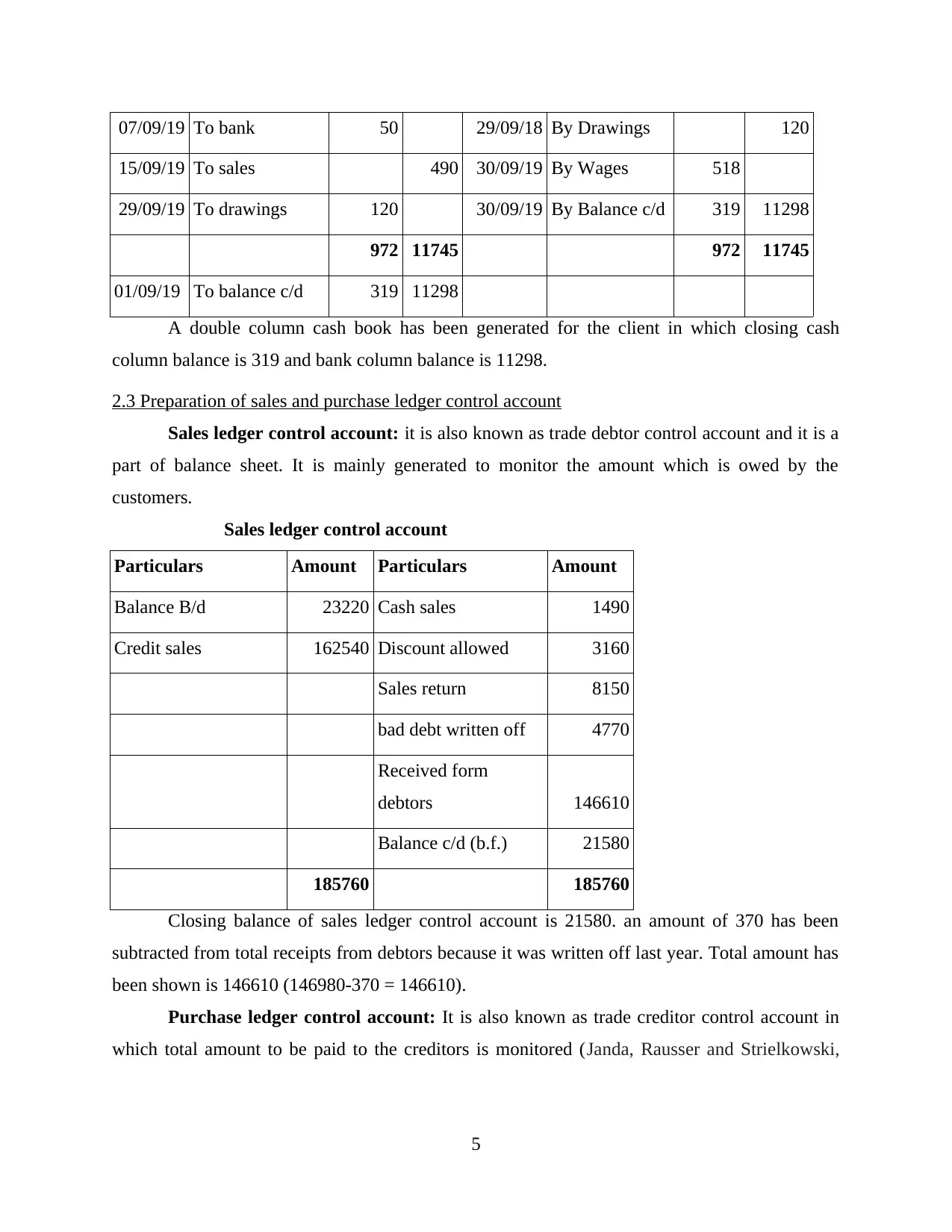
07/09/19 To bank 50 29/09/18 By Drawings 120
15/09/19 To sales 490 30/09/19 By Wages 518
29/09/19 To drawings 120 30/09/19 By Balance c/d 319 11298
972 11745 972 11745
01/09/19 To balance c/d 319 11298
A double column cash book has been generated for the client in which closing cash
column balance is 319 and bank column balance is 11298.
2.3 Preparation of sales and purchase ledger control account
Sales ledger control account: it is also known as trade debtor control account and it is a
part of balance sheet. It is mainly generated to monitor the amount which is owed by the
customers.
Sales ledger control account
Particulars Amount Particulars Amount
Balance B/d 23220 Cash sales 1490
Credit sales 162540 Discount allowed 3160
Sales return 8150
bad debt written off 4770
Received form
debtors 146610
Balance c/d (b.f.) 21580
185760 185760
Closing balance of sales ledger control account is 21580. an amount of 370 has been
subtracted from total receipts from debtors because it was written off last year. Total amount has
been shown is 146610 (146980-370 = 146610).
Purchase ledger control account: It is also known as trade creditor control account in
which total amount to be paid to the creditors is monitored (Janda, Rausser and Strielkowski,
5
15/09/19 To sales 490 30/09/19 By Wages 518
29/09/19 To drawings 120 30/09/19 By Balance c/d 319 11298
972 11745 972 11745
01/09/19 To balance c/d 319 11298
A double column cash book has been generated for the client in which closing cash
column balance is 319 and bank column balance is 11298.
2.3 Preparation of sales and purchase ledger control account
Sales ledger control account: it is also known as trade debtor control account and it is a
part of balance sheet. It is mainly generated to monitor the amount which is owed by the
customers.
Sales ledger control account
Particulars Amount Particulars Amount
Balance B/d 23220 Cash sales 1490
Credit sales 162540 Discount allowed 3160
Sales return 8150
bad debt written off 4770
Received form
debtors 146610
Balance c/d (b.f.) 21580
185760 185760
Closing balance of sales ledger control account is 21580. an amount of 370 has been
subtracted from total receipts from debtors because it was written off last year. Total amount has
been shown is 146610 (146980-370 = 146610).
Purchase ledger control account: It is also known as trade creditor control account in
which total amount to be paid to the creditors is monitored (Janda, Rausser and Strielkowski,
5
Paraphrase This Document
Need a fresh take? Get an instant paraphrase of this document with our AI Paraphraser
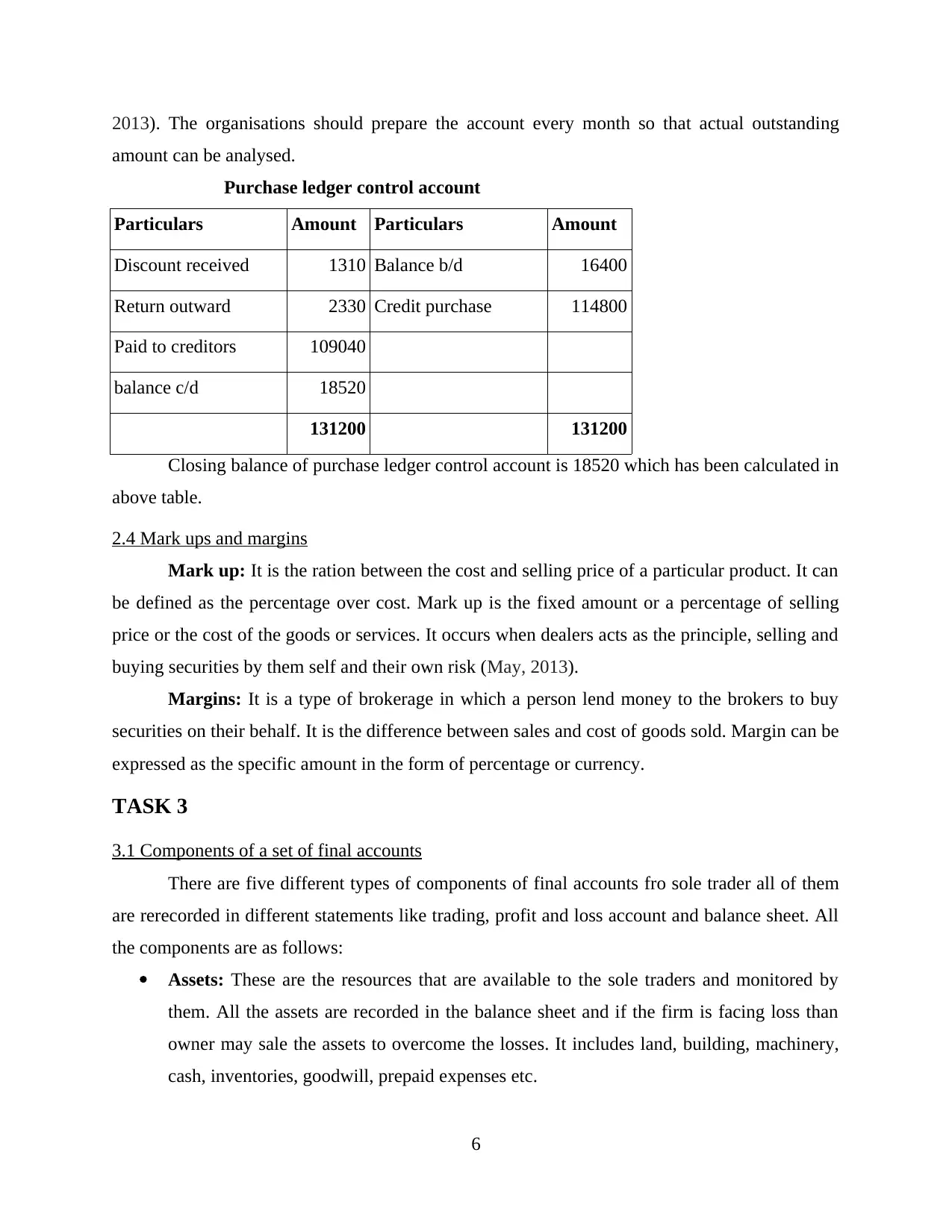
2013). The organisations should prepare the account every month so that actual outstanding
amount can be analysed.
Purchase ledger control account
Particulars Amount Particulars Amount
Discount received 1310 Balance b/d 16400
Return outward 2330 Credit purchase 114800
Paid to creditors 109040
balance c/d 18520
131200 131200
Closing balance of purchase ledger control account is 18520 which has been calculated in
above table.
2.4 Mark ups and margins
Mark up: It is the ration between the cost and selling price of a particular product. It can
be defined as the percentage over cost. Mark up is the fixed amount or a percentage of selling
price or the cost of the goods or services. It occurs when dealers acts as the principle, selling and
buying securities by them self and their own risk (May, 2013).
Margins: It is a type of brokerage in which a person lend money to the brokers to buy
securities on their behalf. It is the difference between sales and cost of goods sold. Margin can be
expressed as the specific amount in the form of percentage or currency.
TASK 3
3.1 Components of a set of final accounts
There are five different types of components of final accounts fro sole trader all of them
are rerecorded in different statements like trading, profit and loss account and balance sheet. All
the components are as follows:
Assets: These are the resources that are available to the sole traders and monitored by
them. All the assets are recorded in the balance sheet and if the firm is facing loss than
owner may sale the assets to overcome the losses. It includes land, building, machinery,
cash, inventories, goodwill, prepaid expenses etc.
6
amount can be analysed.
Purchase ledger control account
Particulars Amount Particulars Amount
Discount received 1310 Balance b/d 16400
Return outward 2330 Credit purchase 114800
Paid to creditors 109040
balance c/d 18520
131200 131200
Closing balance of purchase ledger control account is 18520 which has been calculated in
above table.
2.4 Mark ups and margins
Mark up: It is the ration between the cost and selling price of a particular product. It can
be defined as the percentage over cost. Mark up is the fixed amount or a percentage of selling
price or the cost of the goods or services. It occurs when dealers acts as the principle, selling and
buying securities by them self and their own risk (May, 2013).
Margins: It is a type of brokerage in which a person lend money to the brokers to buy
securities on their behalf. It is the difference between sales and cost of goods sold. Margin can be
expressed as the specific amount in the form of percentage or currency.
TASK 3
3.1 Components of a set of final accounts
There are five different types of components of final accounts fro sole trader all of them
are rerecorded in different statements like trading, profit and loss account and balance sheet. All
the components are as follows:
Assets: These are the resources that are available to the sole traders and monitored by
them. All the assets are recorded in the balance sheet and if the firm is facing loss than
owner may sale the assets to overcome the losses. It includes land, building, machinery,
cash, inventories, goodwill, prepaid expenses etc.
6
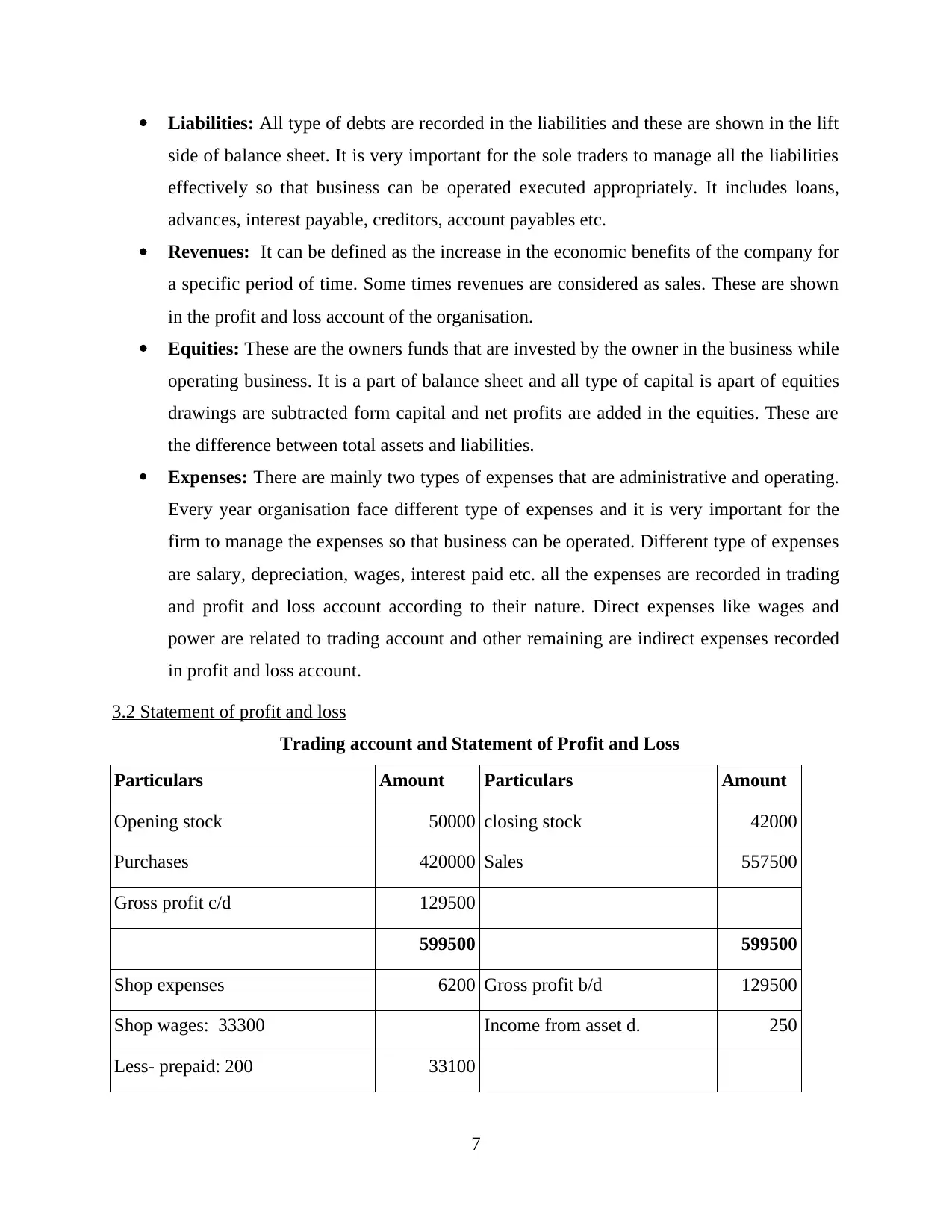
Liabilities: All type of debts are recorded in the liabilities and these are shown in the lift
side of balance sheet. It is very important for the sole traders to manage all the liabilities
effectively so that business can be operated executed appropriately. It includes loans,
advances, interest payable, creditors, account payables etc.
Revenues: It can be defined as the increase in the economic benefits of the company for
a specific period of time. Some times revenues are considered as sales. These are shown
in the profit and loss account of the organisation.
Equities: These are the owners funds that are invested by the owner in the business while
operating business. It is a part of balance sheet and all type of capital is apart of equities
drawings are subtracted form capital and net profits are added in the equities. These are
the difference between total assets and liabilities.
Expenses: There are mainly two types of expenses that are administrative and operating.
Every year organisation face different type of expenses and it is very important for the
firm to manage the expenses so that business can be operated. Different type of expenses
are salary, depreciation, wages, interest paid etc. all the expenses are recorded in trading
and profit and loss account according to their nature. Direct expenses like wages and
power are related to trading account and other remaining are indirect expenses recorded
in profit and loss account.
3.2 Statement of profit and loss
Trading account and Statement of Profit and Loss
Particulars Amount Particulars Amount
Opening stock 50000 closing stock 42000
Purchases 420000 Sales 557500
Gross profit c/d 129500
599500 599500
Shop expenses 6200 Gross profit b/d 129500
Shop wages: 33300 Income from asset d. 250
Less- prepaid: 200 33100
7
side of balance sheet. It is very important for the sole traders to manage all the liabilities
effectively so that business can be operated executed appropriately. It includes loans,
advances, interest payable, creditors, account payables etc.
Revenues: It can be defined as the increase in the economic benefits of the company for
a specific period of time. Some times revenues are considered as sales. These are shown
in the profit and loss account of the organisation.
Equities: These are the owners funds that are invested by the owner in the business while
operating business. It is a part of balance sheet and all type of capital is apart of equities
drawings are subtracted form capital and net profits are added in the equities. These are
the difference between total assets and liabilities.
Expenses: There are mainly two types of expenses that are administrative and operating.
Every year organisation face different type of expenses and it is very important for the
firm to manage the expenses so that business can be operated. Different type of expenses
are salary, depreciation, wages, interest paid etc. all the expenses are recorded in trading
and profit and loss account according to their nature. Direct expenses like wages and
power are related to trading account and other remaining are indirect expenses recorded
in profit and loss account.
3.2 Statement of profit and loss
Trading account and Statement of Profit and Loss
Particulars Amount Particulars Amount
Opening stock 50000 closing stock 42000
Purchases 420000 Sales 557500
Gross profit c/d 129500
599500 599500
Shop expenses 6200 Gross profit b/d 129500
Shop wages: 33300 Income from asset d. 250
Less- prepaid: 200 33100
7
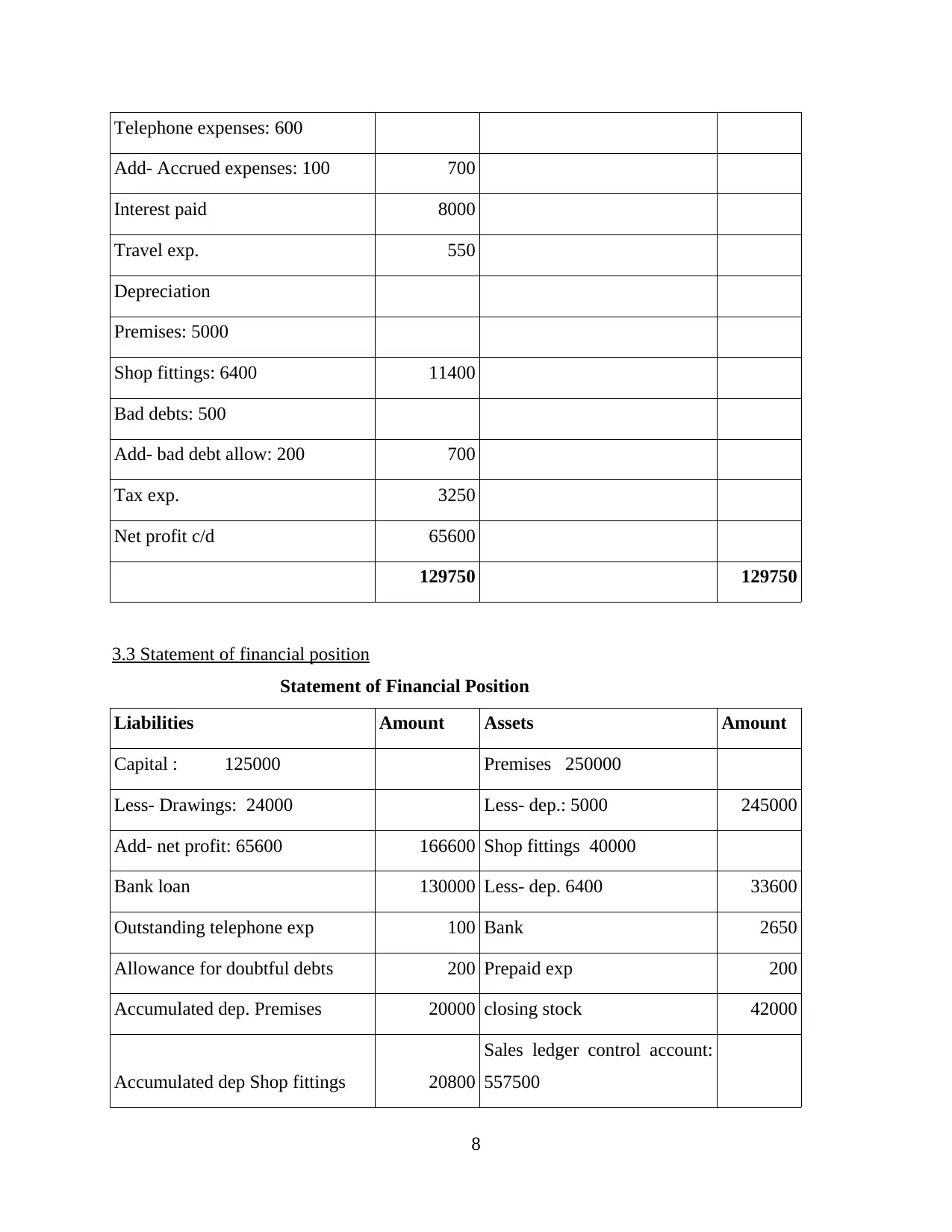
Telephone expenses: 600
Add- Accrued expenses: 100 700
Interest paid 8000
Travel exp. 550
Depreciation
Premises: 5000
Shop fittings: 6400 11400
Bad debts: 500
Add- bad debt allow: 200 700
Tax exp. 3250
Net profit c/d 65600
129750 129750
3.3 Statement of financial position
Statement of Financial Position
Liabilities Amount Assets Amount
Capital : 125000 Premises 250000
Less- Drawings: 24000 Less- dep.: 5000 245000
Add- net profit: 65600 166600 Shop fittings 40000
Bank loan 130000 Less- dep. 6400 33600
Outstanding telephone exp 100 Bank 2650
Allowance for doubtful debts 200 Prepaid exp 200
Accumulated dep. Premises 20000 closing stock 42000
Accumulated dep Shop fittings 20800
Sales ledger control account:
557500
8
Add- Accrued expenses: 100 700
Interest paid 8000
Travel exp. 550
Depreciation
Premises: 5000
Shop fittings: 6400 11400
Bad debts: 500
Add- bad debt allow: 200 700
Tax exp. 3250
Net profit c/d 65600
129750 129750
3.3 Statement of financial position
Statement of Financial Position
Liabilities Amount Assets Amount
Capital : 125000 Premises 250000
Less- Drawings: 24000 Less- dep.: 5000 245000
Add- net profit: 65600 166600 Shop fittings 40000
Bank loan 130000 Less- dep. 6400 33600
Outstanding telephone exp 100 Bank 2650
Allowance for doubtful debts 200 Prepaid exp 200
Accumulated dep. Premises 20000 closing stock 42000
Accumulated dep Shop fittings 20800
Sales ledger control account:
557500
8
Secure Best Marks with AI Grader
Need help grading? Try our AI Grader for instant feedback on your assignments.
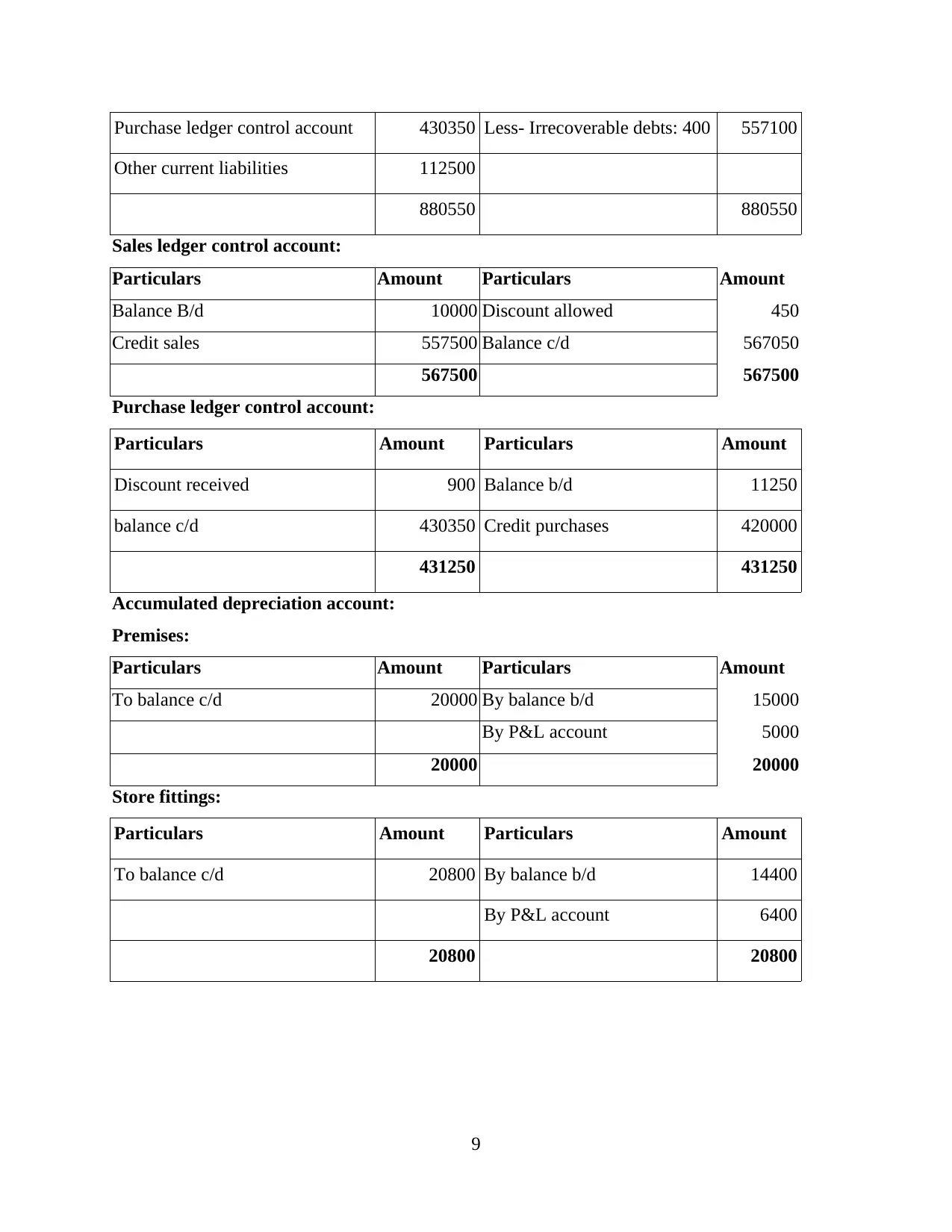
Purchase ledger control account 430350 Less- Irrecoverable debts: 400 557100
Other current liabilities 112500
880550 880550
Sales ledger control account:
Particulars Amount Particulars Amount
Balance B/d 10000 Discount allowed 450
Credit sales 557500 Balance c/d 567050
567500 567500
Purchase ledger control account:
Particulars Amount Particulars Amount
Discount received 900 Balance b/d 11250
balance c/d 430350 Credit purchases 420000
431250 431250
Accumulated depreciation account:
Premises:
Particulars Amount Particulars Amount
To balance c/d 20000 By balance b/d 15000
By P&L account 5000
20000 20000
Store fittings:
Particulars Amount Particulars Amount
To balance c/d 20800 By balance b/d 14400
By P&L account 6400
20800 20800
9
Other current liabilities 112500
880550 880550
Sales ledger control account:
Particulars Amount Particulars Amount
Balance B/d 10000 Discount allowed 450
Credit sales 557500 Balance c/d 567050
567500 567500
Purchase ledger control account:
Particulars Amount Particulars Amount
Discount received 900 Balance b/d 11250
balance c/d 430350 Credit purchases 420000
431250 431250
Accumulated depreciation account:
Premises:
Particulars Amount Particulars Amount
To balance c/d 20000 By balance b/d 15000
By P&L account 5000
20000 20000
Store fittings:
Particulars Amount Particulars Amount
To balance c/d 20800 By balance b/d 14400
By P&L account 6400
20800 20800
9
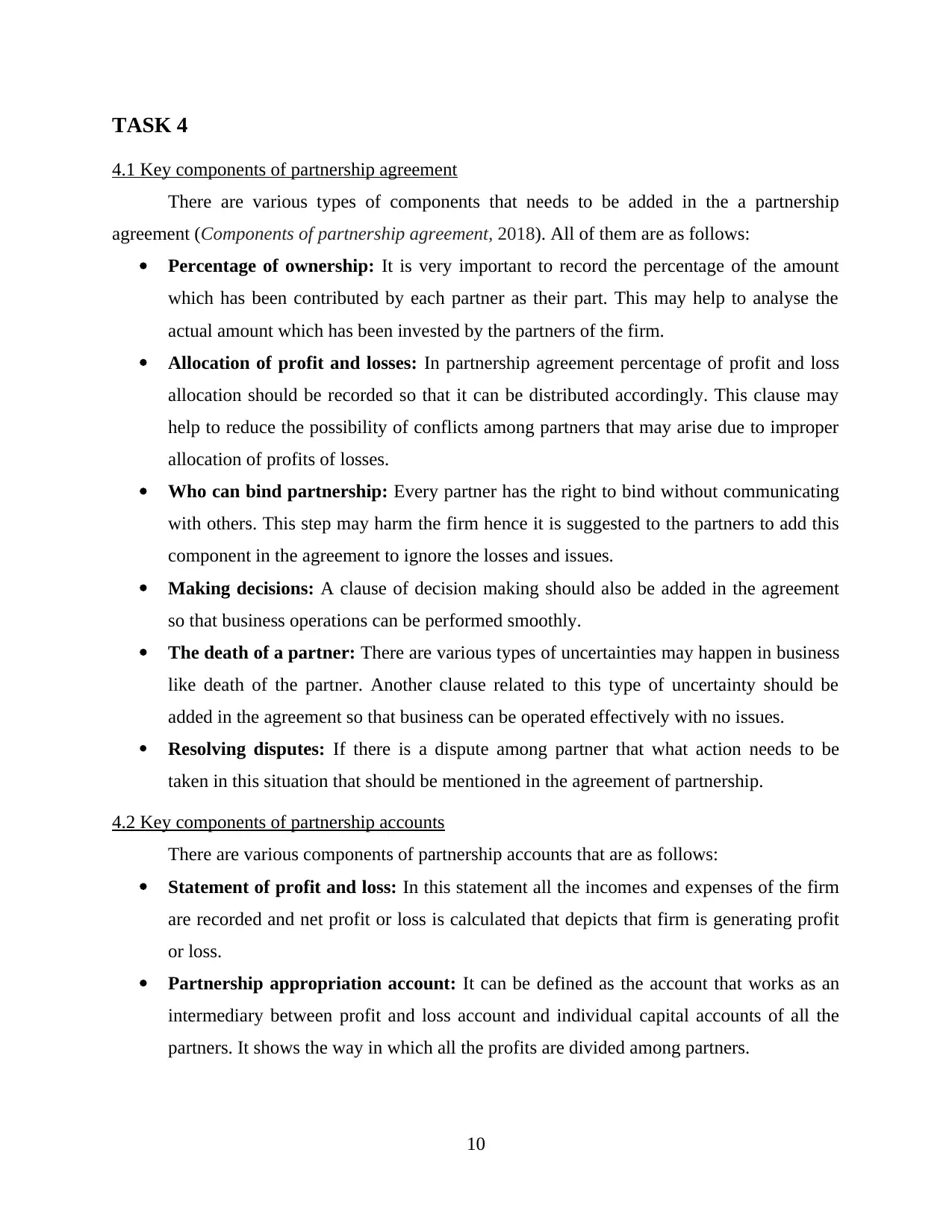
TASK 4
4.1 Key components of partnership agreement
There are various types of components that needs to be added in the a partnership
agreement (Components of partnership agreement, 2018). All of them are as follows:
Percentage of ownership: It is very important to record the percentage of the amount
which has been contributed by each partner as their part. This may help to analyse the
actual amount which has been invested by the partners of the firm.
Allocation of profit and losses: In partnership agreement percentage of profit and loss
allocation should be recorded so that it can be distributed accordingly. This clause may
help to reduce the possibility of conflicts among partners that may arise due to improper
allocation of profits of losses.
Who can bind partnership: Every partner has the right to bind without communicating
with others. This step may harm the firm hence it is suggested to the partners to add this
component in the agreement to ignore the losses and issues.
Making decisions: A clause of decision making should also be added in the agreement
so that business operations can be performed smoothly.
The death of a partner: There are various types of uncertainties may happen in business
like death of the partner. Another clause related to this type of uncertainty should be
added in the agreement so that business can be operated effectively with no issues.
Resolving disputes: If there is a dispute among partner that what action needs to be
taken in this situation that should be mentioned in the agreement of partnership.
4.2 Key components of partnership accounts
There are various components of partnership accounts that are as follows:
Statement of profit and loss: In this statement all the incomes and expenses of the firm
are recorded and net profit or loss is calculated that depicts that firm is generating profit
or loss.
Partnership appropriation account: It can be defined as the account that works as an
intermediary between profit and loss account and individual capital accounts of all the
partners. It shows the way in which all the profits are divided among partners.
10
4.1 Key components of partnership agreement
There are various types of components that needs to be added in the a partnership
agreement (Components of partnership agreement, 2018). All of them are as follows:
Percentage of ownership: It is very important to record the percentage of the amount
which has been contributed by each partner as their part. This may help to analyse the
actual amount which has been invested by the partners of the firm.
Allocation of profit and losses: In partnership agreement percentage of profit and loss
allocation should be recorded so that it can be distributed accordingly. This clause may
help to reduce the possibility of conflicts among partners that may arise due to improper
allocation of profits of losses.
Who can bind partnership: Every partner has the right to bind without communicating
with others. This step may harm the firm hence it is suggested to the partners to add this
component in the agreement to ignore the losses and issues.
Making decisions: A clause of decision making should also be added in the agreement
so that business operations can be performed smoothly.
The death of a partner: There are various types of uncertainties may happen in business
like death of the partner. Another clause related to this type of uncertainty should be
added in the agreement so that business can be operated effectively with no issues.
Resolving disputes: If there is a dispute among partner that what action needs to be
taken in this situation that should be mentioned in the agreement of partnership.
4.2 Key components of partnership accounts
There are various components of partnership accounts that are as follows:
Statement of profit and loss: In this statement all the incomes and expenses of the firm
are recorded and net profit or loss is calculated that depicts that firm is generating profit
or loss.
Partnership appropriation account: It can be defined as the account that works as an
intermediary between profit and loss account and individual capital accounts of all the
partners. It shows the way in which all the profits are divided among partners.
10
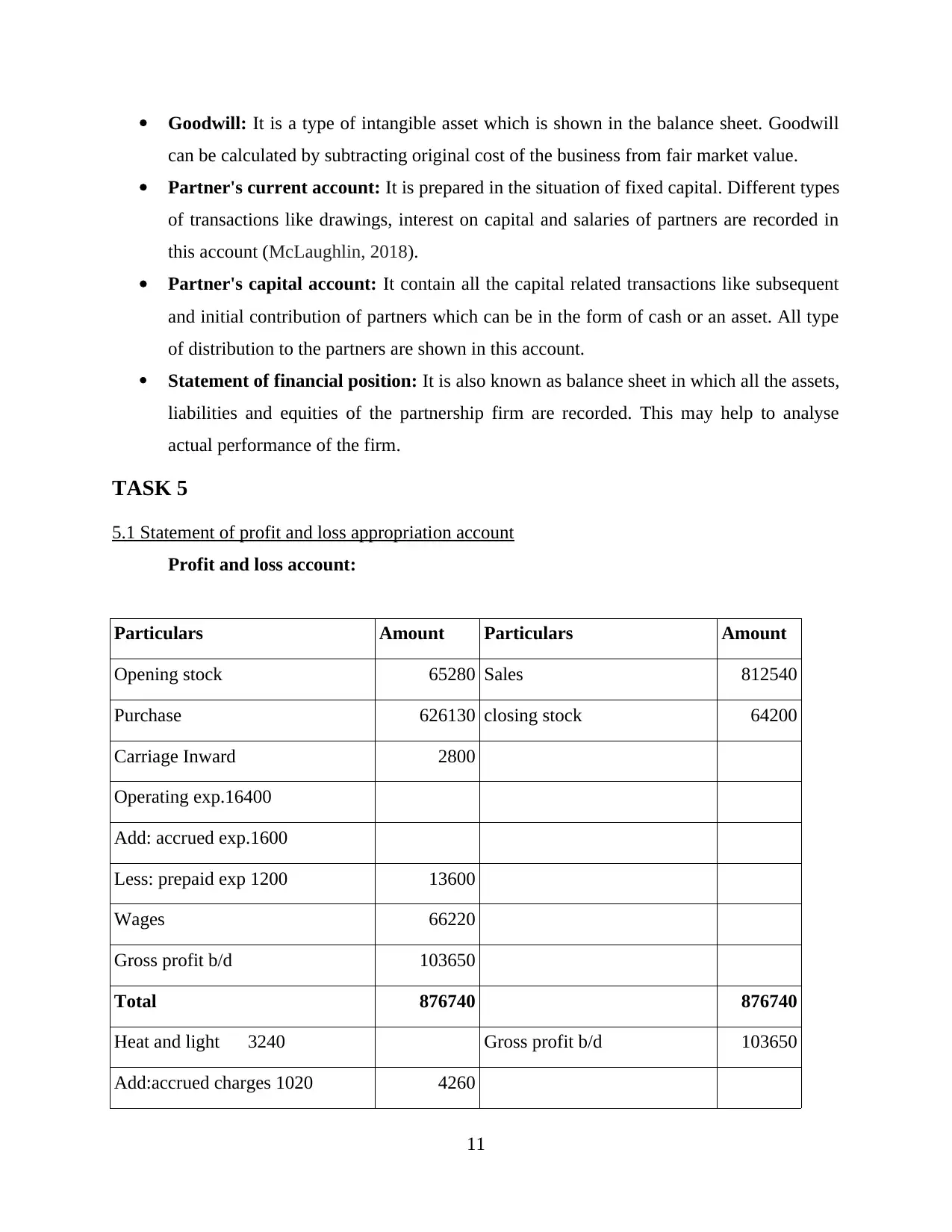
Goodwill: It is a type of intangible asset which is shown in the balance sheet. Goodwill
can be calculated by subtracting original cost of the business from fair market value.
Partner's current account: It is prepared in the situation of fixed capital. Different types
of transactions like drawings, interest on capital and salaries of partners are recorded in
this account (McLaughlin, 2018).
Partner's capital account: It contain all the capital related transactions like subsequent
and initial contribution of partners which can be in the form of cash or an asset. All type
of distribution to the partners are shown in this account.
Statement of financial position: It is also known as balance sheet in which all the assets,
liabilities and equities of the partnership firm are recorded. This may help to analyse
actual performance of the firm.
TASK 5
5.1 Statement of profit and loss appropriation account
Profit and loss account:
Particulars Amount Particulars Amount
Opening stock 65280 Sales 812540
Purchase 626130 closing stock 64200
Carriage Inward 2800
Operating exp.16400
Add: accrued exp.1600
Less: prepaid exp 1200 13600
Wages 66220
Gross profit b/d 103650
Total 876740 876740
Heat and light 3240 Gross profit b/d 103650
Add:accrued charges 1020 4260
11
can be calculated by subtracting original cost of the business from fair market value.
Partner's current account: It is prepared in the situation of fixed capital. Different types
of transactions like drawings, interest on capital and salaries of partners are recorded in
this account (McLaughlin, 2018).
Partner's capital account: It contain all the capital related transactions like subsequent
and initial contribution of partners which can be in the form of cash or an asset. All type
of distribution to the partners are shown in this account.
Statement of financial position: It is also known as balance sheet in which all the assets,
liabilities and equities of the partnership firm are recorded. This may help to analyse
actual performance of the firm.
TASK 5
5.1 Statement of profit and loss appropriation account
Profit and loss account:
Particulars Amount Particulars Amount
Opening stock 65280 Sales 812540
Purchase 626130 closing stock 64200
Carriage Inward 2800
Operating exp.16400
Add: accrued exp.1600
Less: prepaid exp 1200 13600
Wages 66220
Gross profit b/d 103650
Total 876740 876740
Heat and light 3240 Gross profit b/d 103650
Add:accrued charges 1020 4260
11
Paraphrase This Document
Need a fresh take? Get an instant paraphrase of this document with our AI Paraphraser
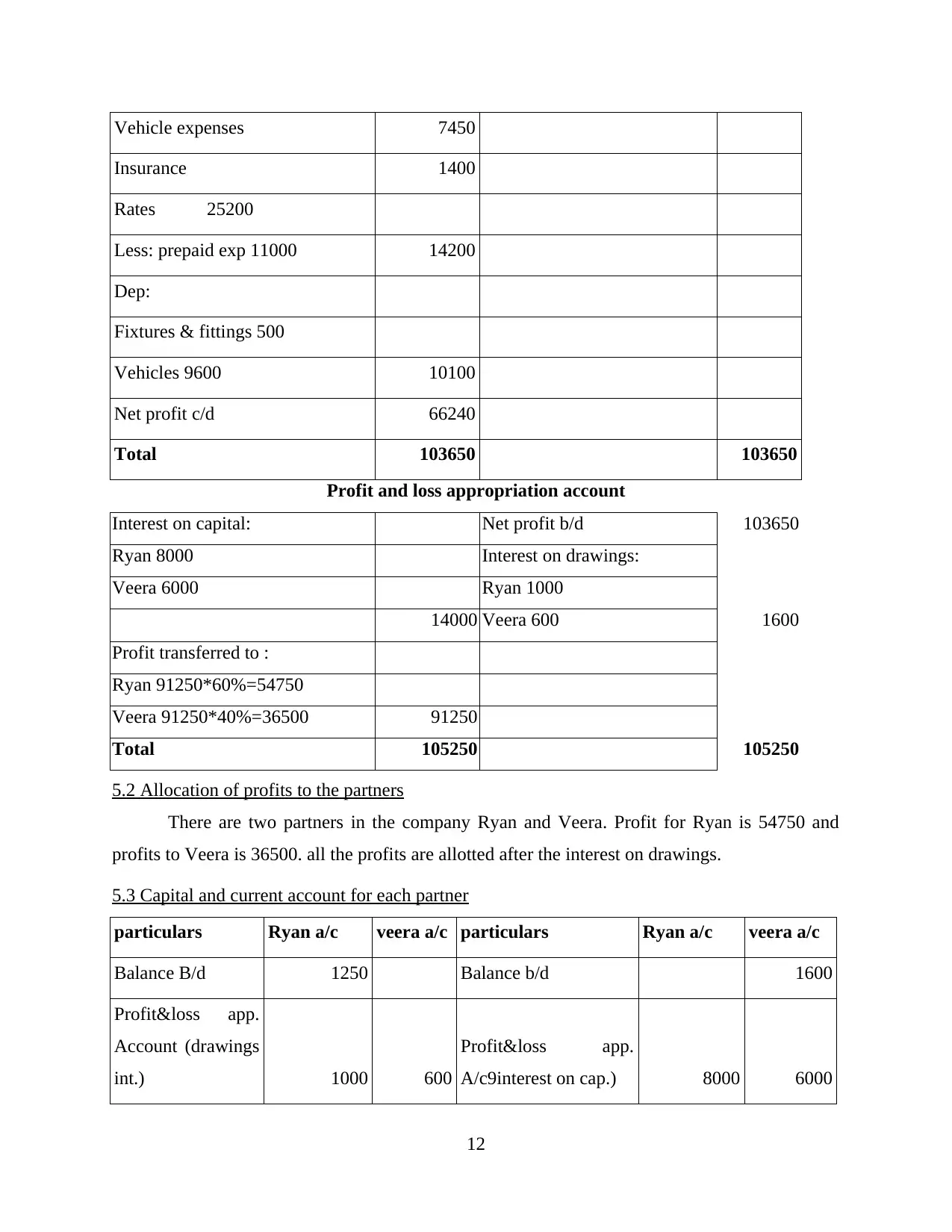
Vehicle expenses 7450
Insurance 1400
Rates 25200
Less: prepaid exp 11000 14200
Dep:
Fixtures & fittings 500
Vehicles 9600 10100
Net profit c/d 66240
Total 103650 103650
Profit and loss appropriation account
Interest on capital: Net profit b/d 103650
Ryan 8000 Interest on drawings:
Veera 6000 Ryan 1000
14000 Veera 600 1600
Profit transferred to :
Ryan 91250*60%=54750
Veera 91250*40%=36500 91250
Total 105250 105250
5.2 Allocation of profits to the partners
There are two partners in the company Ryan and Veera. Profit for Ryan is 54750 and
profits to Veera is 36500. all the profits are allotted after the interest on drawings.
5.3 Capital and current account for each partner
particulars Ryan a/c veera a/c particulars Ryan a/c veera a/c
Balance B/d 1250 Balance b/d 1600
Profit&loss app.
Account (drawings
int.) 1000 600
Profit&loss app.
A/c9interest on cap.) 8000 6000
12
Insurance 1400
Rates 25200
Less: prepaid exp 11000 14200
Dep:
Fixtures & fittings 500
Vehicles 9600 10100
Net profit c/d 66240
Total 103650 103650
Profit and loss appropriation account
Interest on capital: Net profit b/d 103650
Ryan 8000 Interest on drawings:
Veera 6000 Ryan 1000
14000 Veera 600 1600
Profit transferred to :
Ryan 91250*60%=54750
Veera 91250*40%=36500 91250
Total 105250 105250
5.2 Allocation of profits to the partners
There are two partners in the company Ryan and Veera. Profit for Ryan is 54750 and
profits to Veera is 36500. all the profits are allotted after the interest on drawings.
5.3 Capital and current account for each partner
particulars Ryan a/c veera a/c particulars Ryan a/c veera a/c
Balance B/d 1250 Balance b/d 1600
Profit&loss app.
Account (drawings
int.) 1000 600
Profit&loss app.
A/c9interest on cap.) 8000 6000
12
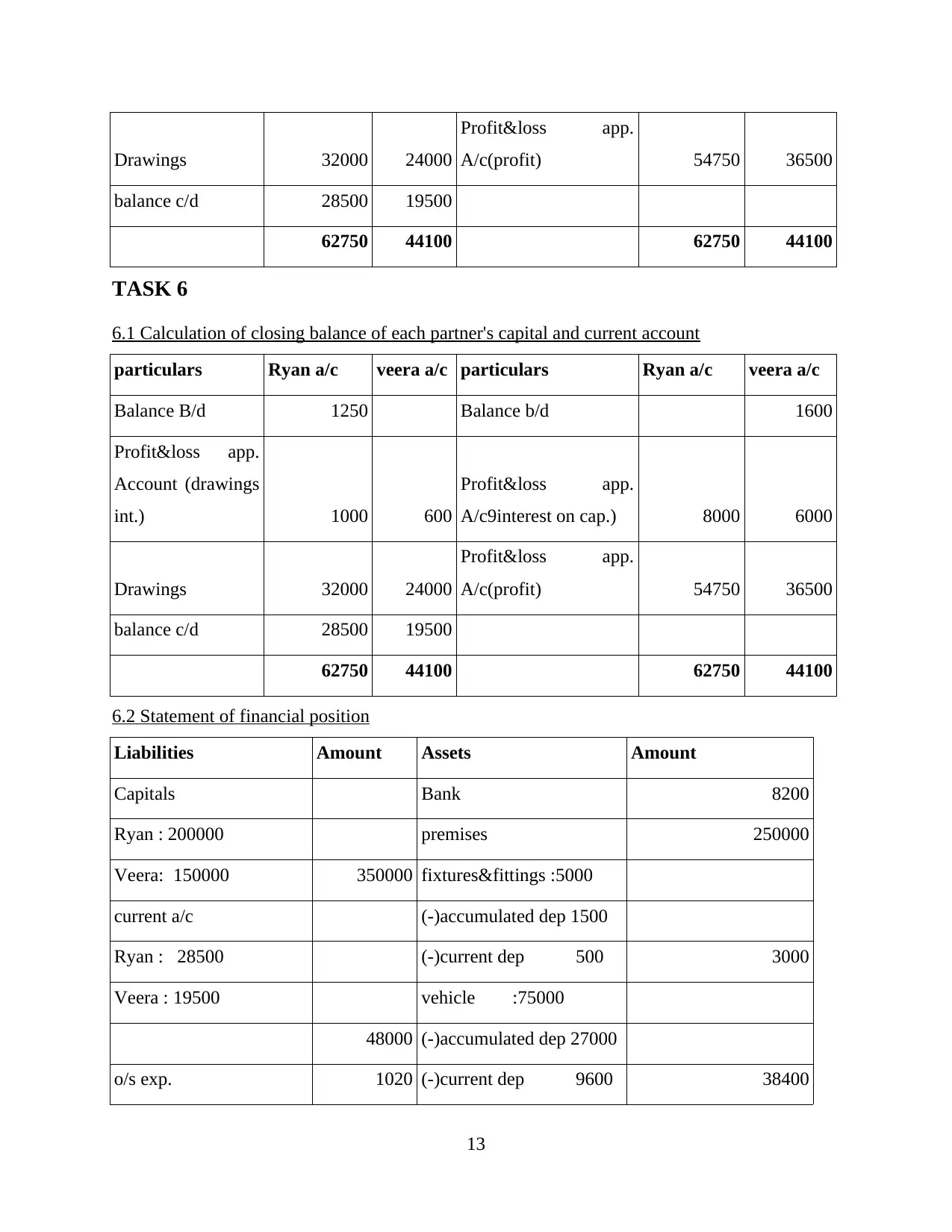
Drawings 32000 24000
Profit&loss app.
A/c(profit) 54750 36500
balance c/d 28500 19500
62750 44100 62750 44100
TASK 6
6.1 Calculation of closing balance of each partner's capital and current account
particulars Ryan a/c veera a/c particulars Ryan a/c veera a/c
Balance B/d 1250 Balance b/d 1600
Profit&loss app.
Account (drawings
int.) 1000 600
Profit&loss app.
A/c9interest on cap.) 8000 6000
Drawings 32000 24000
Profit&loss app.
A/c(profit) 54750 36500
balance c/d 28500 19500
62750 44100 62750 44100
6.2 Statement of financial position
Liabilities Amount Assets Amount
Capitals Bank 8200
Ryan : 200000 premises 250000
Veera: 150000 350000 fixtures&fittings :5000
current a/c (-)accumulated dep 1500
Ryan : 28500 (-)current dep 500 3000
Veera : 19500 vehicle :75000
48000 (-)accumulated dep 27000
o/s exp. 1020 (-)current dep 9600 38400
13
Profit&loss app.
A/c(profit) 54750 36500
balance c/d 28500 19500
62750 44100 62750 44100
TASK 6
6.1 Calculation of closing balance of each partner's capital and current account
particulars Ryan a/c veera a/c particulars Ryan a/c veera a/c
Balance B/d 1250 Balance b/d 1600
Profit&loss app.
Account (drawings
int.) 1000 600
Profit&loss app.
A/c9interest on cap.) 8000 6000
Drawings 32000 24000
Profit&loss app.
A/c(profit) 54750 36500
balance c/d 28500 19500
62750 44100 62750 44100
6.2 Statement of financial position
Liabilities Amount Assets Amount
Capitals Bank 8200
Ryan : 200000 premises 250000
Veera: 150000 350000 fixtures&fittings :5000
current a/c (-)accumulated dep 1500
Ryan : 28500 (-)current dep 500 3000
Veera : 19500 vehicle :75000
48000 (-)accumulated dep 27000
o/s exp. 1020 (-)current dep 9600 38400
13
1 out of 15
Related Documents
Your All-in-One AI-Powered Toolkit for Academic Success.
+13062052269
info@desklib.com
Available 24*7 on WhatsApp / Email
![[object Object]](/_next/static/media/star-bottom.7253800d.svg)
Unlock your academic potential
© 2024 | Zucol Services PVT LTD | All rights reserved.





